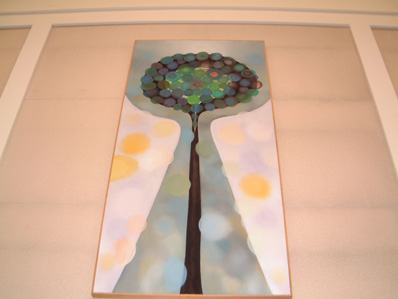Alice Mavrogordato’s Legacy
by Margareta Ploder
Entering the atrium of the Austrian Embassy in Washington, D.C., anyone’s eye is immediately caught by five huge paintings on the front wall. Their clear, organic forms create an atmosphere of mysterious dignity and calmness that is subtly balanced with the dynamism of rich colors. These five variations on the theme of "Strange Trees" convey a positive message of the eternal metamorphosis that is life.

One of the "Strange Trees" displayed at the Austrian Embassy
The painter that so greatly contributed to the Embassy's "face" is Alice Mavrogordato. She was born in Vienna in 1916, forced by the Nazis to leave Austria as a Jewish refugee, survived World War II in Great Britain and served as a translator at the Nuremberg War Crimes Trials where she met her husband Ralph. The couple moved to the U.S. in 1951 and settled in the Washington, D.C. area, where Alice worked as an artist. She died in 2000. In a most noble gesture towards her country of origin she bequeathed her estate, a body of more than 300 graphic works and paintings, to the Republic of Austria. Mr. Ralph Mavrogordato and the Ambassador of Austria, Eva Nowotny, signed the Deed of Gift last month.
Alice Mavrogordato is often identified with the "Washington Color School," featuring abundant colors and staining techniques in abstract compositions. Influences by her teachers, Kenneth Noland and Morris Louis, are obvious. However, she developed a highly individual style characterized by a distinct musical approach and a humorous attitude. Her works have been described as painted music, sometimes fugues, sometimes symphonies, nocturnes, capriccios or variations, with a clear though sophisticatedly-varied rhythmic order. In her later oeuvre this also translates into figurative elements and a more reduced color palette. Ms. Mavrogordato had several solo shows in the Washington area and was a charter member of the Origo Gallery. In Vienna her art was shown in 1995 at the Palais Pálffy within the context of the symposium "Women in Exile."
Austria accepts the generous gift of Alice and Ralph Mavrogordato with deep appreciation and gratitude. Some of the works will be made available to Vienna’s Jewish Museum and the Historic Museum. Others will be displayed at Austrian embassies, thus contributing to Austria’s representation in the world. Alice Mavrogordato’s legacy, as an artist and an Austrian who tragically had to leave her country but returned through her art, will live on.
Entering the atrium of the Austrian Embassy in Washington, D.C., anyone’s eye is immediately caught by five huge paintings on the front wall. Their clear, organic forms create an atmosphere of mysterious dignity and calmness that is subtly balanced with the dynamism of rich colors. These five variations on the theme of "Strange Trees" convey a positive message of the eternal metamorphosis that is life.

One of the "Strange Trees" displayed at the Austrian Embassy
The painter that so greatly contributed to the Embassy's "face" is Alice Mavrogordato. She was born in Vienna in 1916, forced by the Nazis to leave Austria as a Jewish refugee, survived World War II in Great Britain and served as a translator at the Nuremberg War Crimes Trials where she met her husband Ralph. The couple moved to the U.S. in 1951 and settled in the Washington, D.C. area, where Alice worked as an artist. She died in 2000. In a most noble gesture towards her country of origin she bequeathed her estate, a body of more than 300 graphic works and paintings, to the Republic of Austria. Mr. Ralph Mavrogordato and the Ambassador of Austria, Eva Nowotny, signed the Deed of Gift last month.
Alice Mavrogordato is often identified with the "Washington Color School," featuring abundant colors and staining techniques in abstract compositions. Influences by her teachers, Kenneth Noland and Morris Louis, are obvious. However, she developed a highly individual style characterized by a distinct musical approach and a humorous attitude. Her works have been described as painted music, sometimes fugues, sometimes symphonies, nocturnes, capriccios or variations, with a clear though sophisticatedly-varied rhythmic order. In her later oeuvre this also translates into figurative elements and a more reduced color palette. Ms. Mavrogordato had several solo shows in the Washington area and was a charter member of the Origo Gallery. In Vienna her art was shown in 1995 at the Palais Pálffy within the context of the symposium "Women in Exile."
Austria accepts the generous gift of Alice and Ralph Mavrogordato with deep appreciation and gratitude. Some of the works will be made available to Vienna’s Jewish Museum and the Historic Museum. Others will be displayed at Austrian embassies, thus contributing to Austria’s representation in the world. Alice Mavrogordato’s legacy, as an artist and an Austrian who tragically had to leave her country but returned through her art, will live on.
